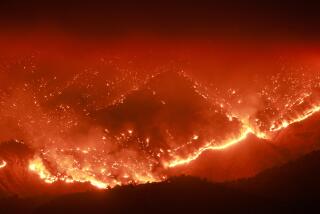Crews Lose, Regain Ground in Blaze Near Palomar Mountain
- Share via
Weary firefighters lost and then regained ground Saturday to the week-old fire that has been burning near Palomar Mountain when gusty winds pushed the flames northeast, into the reaches of Cutca Valley and away from the Palomar Observatory.
U.S. Forest Service officials said the fire gained the upper hand for several hours, frustrating the efforts of 2,062 firefighters who have been battling the stubborn blaze around-the-clock in the Cleveland National Forest. But on Saturday night, Forest Service spokeswoman Rosalinda Ewen said the fire had burned more than 15,100 acres and was 65% contained.
Earlier in the day, officials said the fire had suddenly overwhelmed fire crews and declared the blaze only 40% contained. Containment had been estimated at 58% on Friday. However, late Saturday night Forest Service spokesmen issued their first optimistic prediction in a week, and said they expect to have the fire under control by 8 p.m. Monday. The cost of fighting the fire has been put at $4.4 million so far.
“It’s a frustrating job. The terrain is very steep with very heavy brush, where firefighters and equipment can’t reach,” said fire official Audrey Hagan. “The erratic winds shifted the fire, and we had some blowouts on the east flank, in Cutca Valley.”
In addition to the rough terrain and unpredictable winds, firefighters were also hampered by 96-degree temperatures and 18% humidity. But, Ewen said that Palomar Observatory and Eagle Crag Sanctuary, which is home to endangered golden and bald eagles, are no longer in the fire’s path.
The new area where the fire was burning is so rough that fire crews had to be lifted in and out by helicopters. Firefighters were seemingly reacting to the whim of the gusty winds, which propelled the fire from ridge to ridge and into the rocky, brush-covered ravines that lie in between.
But the fire’s sudden shift in direction also proved to be a blessing for firefighters. Ewen said that fire officials were able to issue optimistic predictions for final containment because the blaze mostly traveled north from Palomar Observatory, into areas that burned in the Aguanga fire of 1985 and the 16,000 acre Palomar fire of 1987.
“There isn’t much left to burn in those areas,” Ewen said.
The fire, which began last Saturday south of Vail Lake in Riverside County, was sparked by a ricocheting bullet fired by a target shooter.
More to Read
Sign up for Essential California
The most important California stories and recommendations in your inbox every morning.
You may occasionally receive promotional content from the Los Angeles Times.













